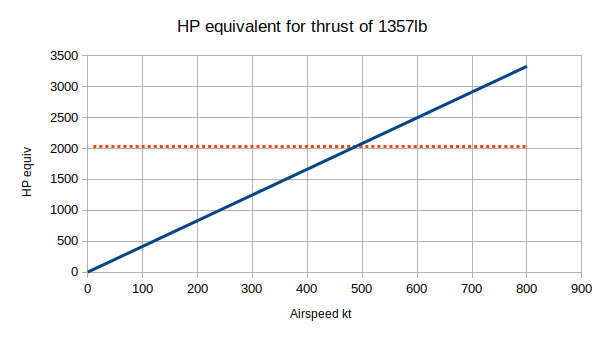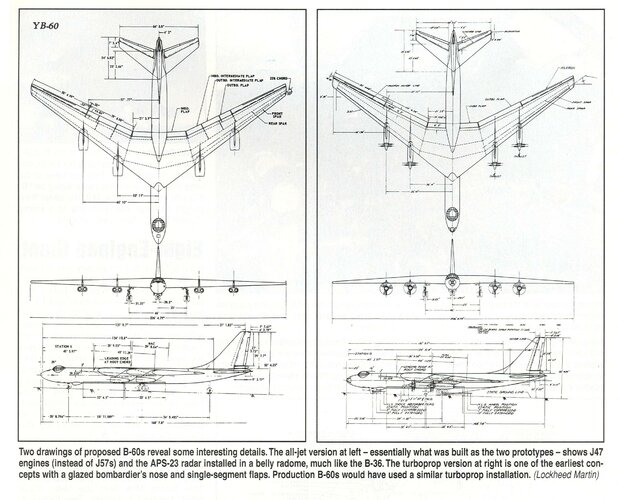Still one of the most interesting turboprop configuration because of the supersonic propeller in addition with afterburning trials - a well researched review:
You are using an out of date browser. It may not display this or other websites correctly.
You should upgrade or use an alternative browser.
You should upgrade or use an alternative browser.
XF-84H Propulsion
- Thread starter Basil
- Start date
Kiltonge
Greetings Earthling
- Joined
- 24 January 2013
- Messages
- 555
- Reaction score
- 934
From that report:
"But it would seem to be a poor tradeoff to give up 2036 horsepower in order to gain 1,357 pounds of jet thrust."
They actually cross over at about 490kt, above that the thrust becomes dominant.

If they were getting 80% efficiency out of the supersonic propellor, that would suggest that thrust could start to edge out the prop from the mid-400kt range. Since the fastest the XF-84H managed on the prop was about 450kt, the use of reheat to try to push it faster makes sense.
"But it would seem to be a poor tradeoff to give up 2036 horsepower in order to gain 1,357 pounds of jet thrust."
They actually cross over at about 490kt, above that the thrust becomes dominant.

If they were getting 80% efficiency out of the supersonic propellor, that would suggest that thrust could start to edge out the prop from the mid-400kt range. Since the fastest the XF-84H managed on the prop was about 450kt, the use of reheat to try to push it faster makes sense.
Last edited:
Interesting calculation but I think the point where exhaust thrust becomes more dominant also changes with flight altitude. Rolls Royce had intersting charts for this when they developed the Crecy and compared exhaust thrust to shaft hp in regards to altitude.
I also wondered why the activation of the afterburner leads to such an amount of hp reduction. Perhaps additional backpressure downside of the turbine?
Btw, afaik the XF-84H was only a testbed for this propulsion system and not a planned production version of the F-84 line.
I also wondered why the activation of the afterburner leads to such an amount of hp reduction. Perhaps additional backpressure downside of the turbine?
Btw, afaik the XF-84H was only a testbed for this propulsion system and not a planned production version of the F-84 line.
Last edited:
My understanding is that the Navy had an interest in this program because of the ongoing concern by some that jet airplanes were not compatible with aircraft carriers. Another example of this concern was the funding of the Convair F2Y seaplane fighter.
Scott Kenny
ACCESS: Above Top Secret
- Joined
- 15 May 2023
- Messages
- 8,642
- Reaction score
- 9,424
Until people figured out how to increase thrust quickly in a jet engine, the best way to add thrust now on approach to a carrier is a controllable pitch prop.My understanding is that the Navy had an interest in this program because of the ongoing concern by some that jet airplanes were not compatible with aircraft carriers. Another example of this concern was the funding of the Convair F2Y seaplane fighter.
P-STICKNEY
ACCESS: Confidential
- Joined
- 28 September 2008
- Messages
- 51
- Reaction score
- 89
That puzzled me, too - until I remembered that scabbed-on "Partial Reheat" used on the last versions of the Brit Javelin interceptors. It was basically one step above a Field Expedient. To make it simple, instead of the Afterburner having it's own fuel pumps, it tapped fuel from the engine's combustor fuel pumps. This reduced fuel to the main gas generator, which meant that at lower altitudes, the core engine was starved of fuel, and produced less thrust. Until the jet had climbed to an altitude where the reduced fuel requirements meant that the fuel pumps had enough excess capacity to get 100% out of the core engine and supply the afterburner, there was a net loss of overall thrust.Interesting calculation but I think the point where exhaust thrust becomes more dominant also changes with flight altitude. Rolls Royce had intersting charts for this when they developed the Crecy and compared exhaust thrust to shaft hp in regards to altitude.
I also wondered why the activation of the afterburner leads to such an amount of hp reduction. Perhaps additional backpressure downside of the turbine?
Btw, afaik the XF-84H was only a testbed for this propulsion system and not a planned production version of the F-84 line.
Sounds like the same thing here.
Scott Kenny
ACCESS: Above Top Secret
- Joined
- 15 May 2023
- Messages
- 8,642
- Reaction score
- 9,424
YIKES!!!!Still not as good as props:View: https://youtu.be/R4DtDu2DNKE?si=Rx1hJo51eSFbaKAi
Bet those two pilots are still looking for their seat cushions after that close call... And the guys in back needed fresh skivvies.
That puzzled me, too - until I remembered that scabbed-on "Partial Reheat" used on the last versions of the Brit Javelin interceptors. It was basically one step above a Field Expedient. To make it simple, instead of the Afterburner having it's own fuel pumps, it tapped fuel from the engine's combustor fuel pumps. This reduced fuel to the main gas generator, which meant that at lower altitudes, the core engine was starved of fuel, and produced less thrust. Until the jet had climbed to an altitude where the reduced fuel requirements meant that the fuel pumps had enough excess capacity to get 100% out of the core engine and supply the afterburner, there was a net loss of overall thrust.
Sounds like the same thing here.
Yes, I also thought about the Javelin; could be the same reason. Btw this (Javelin afterburner) is such a typical British aviation thing - interesting ideas and concepts but not the money or not going the last mile to bring it to a successful end (like installing a larger or second fuel pump).
No offense to british engineering
Scott Kenny
ACCESS: Above Top Secret
- Joined
- 15 May 2023
- Messages
- 8,642
- Reaction score
- 9,424
The problem with British aviation engineering is that it is paid for by the British Treasury. And HMTreasury makes (insert ethnic stereotype of "never spends money" here) look like a wastrel!Yes, I also thought about the Javelin; could be the same reason. Btw this (Javelin afterburner) is such a typical British aviation thing - interesting ideas and concepts but not the money or not going the last mile to bring it to a successful end (like installing a larger or second fuel pump).
No offense to british engineering
- Joined
- 6 November 2010
- Messages
- 4,612
- Reaction score
- 4,066
I know just the stereotype - "a Yorkshireman is a Scotsman with all the generosity squeezed out of him"(insert ethnic stereotype of "never spends money" here)
Lovely place, mind.
It was (is?) not only a thing in the British aviation industry but also in car industry, machinery industry, etc.; but we are straying from the topic.The problem with British aviation engineering is that it is paid for by the British Treasury. And HMTreasury makes (insert ethnic stereotype of "never spends money" here) look like a wastrel!
Nik
ACCESS: Top Secret
- Joined
- 15 July 2009
- Messages
- 1,241
- Reaction score
- 1,002
Concur: My former small corner of UK Big_Pharma had an epic reluctance to spend money between 'flood-gate' purse openings.
The 'Not_Invented_Here' rule also applied: Unless the notion came from 'Off Site', either via a 'Development' lab or eg a Consultant, it was automatically beneath contempt.
Which meant local innovation had to be subtly incremental, sufficiently inexpensive and, above all else, stealthy...
Which usually meant me buying instrument connectivity makings from eg Maplin Electronics' catalogue, hand-wiring the needful...
{ Shakes head...}
The 'Not_Invented_Here' rule also applied: Unless the notion came from 'Off Site', either via a 'Development' lab or eg a Consultant, it was automatically beneath contempt.
Which meant local innovation had to be subtly incremental, sufficiently inexpensive and, above all else, stealthy...
Which usually meant me buying instrument connectivity makings from eg Maplin Electronics' catalogue, hand-wiring the needful...
{ Shakes head...}
Scott Kenny
ACCESS: Above Top Secret
- Joined
- 15 May 2023
- Messages
- 8,642
- Reaction score
- 9,424
I mean, when you're talking about aircraft development, some discussion of the fiscal environment is kinda necessary.It was (is?) not only a thing in the British aviation industry but also in car industry, machinery industry, etc.; but we are straying from the topic.
Similar threads
-
-
Thunderscreech/Supersonic Propeller Aircraft and Psyops
- Started by Delta Force
- Replies: 5
-
-
Experimental and Prototype U.S. Air Force Jet Fighters - Jenkins & Landis
- Started by overscan (PaulMM)
- Replies: 12
-
American Aerospace Archive - Mother Ships, Parasites and More: Bomber, XC Heavy Transport & FICON Studies
- Started by jzichek
- Replies: 45

